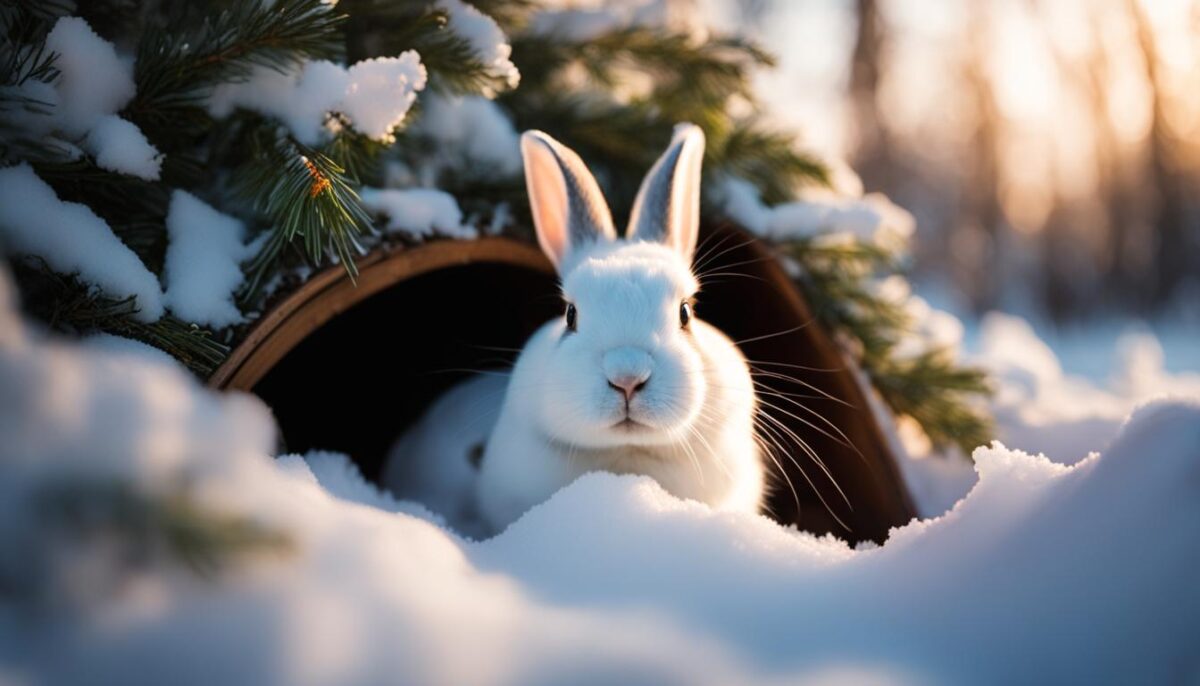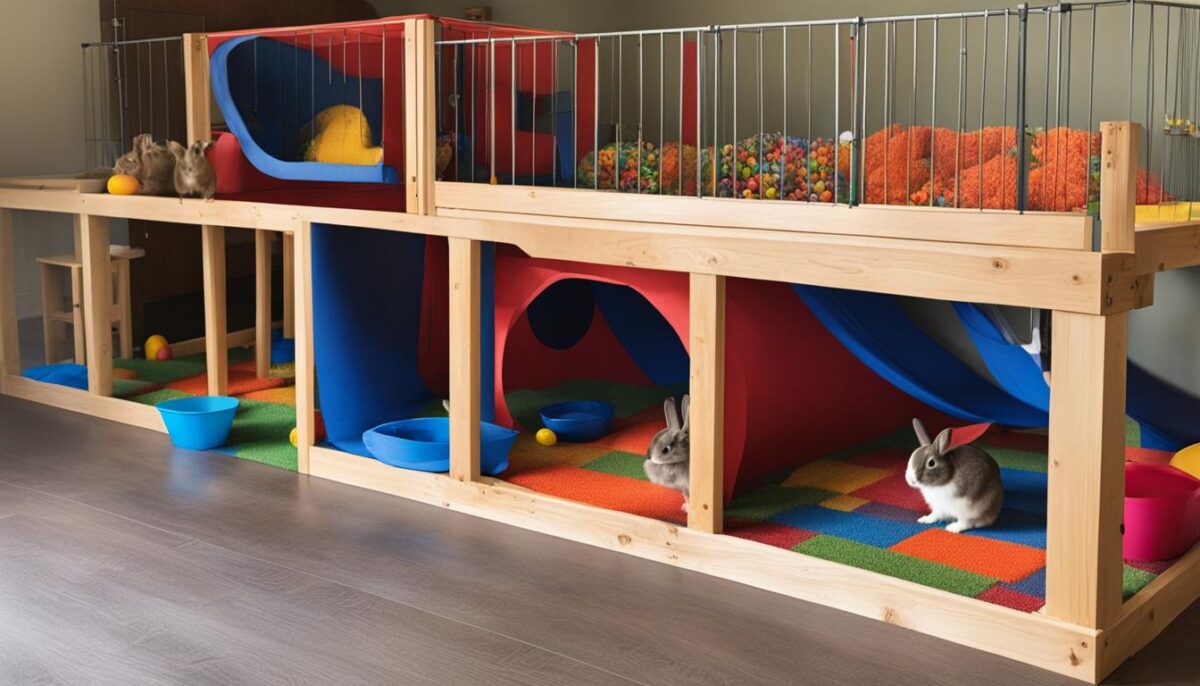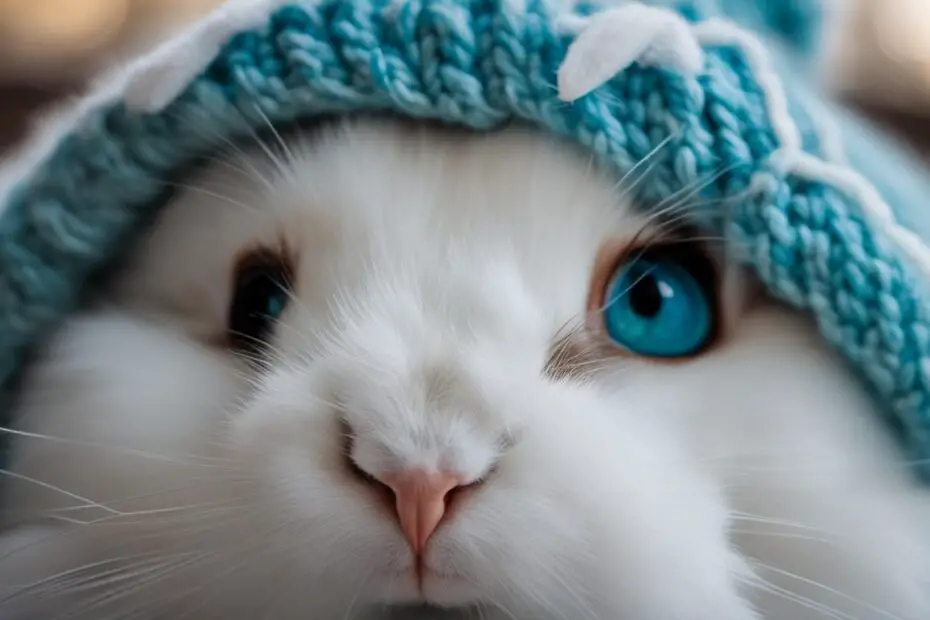During the winter months, it is crucial to ensure that your rabbits stay warm and comfortable. One of the key areas to focus on is keeping their ears warm. Rabbits have large, sensitive ears that can be susceptible to the cold. By taking the right measures, you can help your rabbits stay cozy and protected during the winter season.
Key Takeaways:
- Insulate the rabbit’s hutch using newspaper, warm blankets, and an outdoor tarp to retain heat and protect from snow or rain.
- Check water bottles and bowls frequently to prevent freezing and provide fresh, unfrozen water to your rabbits.
- Consider keeping rabbits in pairs for warmth and companionship, ensuring a gradual introduction and monitoring their interactions.
- Clean the rabbit’s cage regularly to prevent dampness and potential health issues caused by urine clumps.
- Use heated blankets with caution, avoiding unsupervised use and preventing contact with flammable materials.
Making Sure Water Bottles and Bowls Don’t Freeze
In cold winter months, one of the challenges rabbit owners face is ensuring that their pets have access to unfrozen water. Frozen water bottles and bowls can leave rabbits without hydration, leading to potential health issues. Here are some tips to prevent water freezing and ensure your rabbits stay hydrated during the winter:
Preventing Water from Freezing
- Check water bottles and bowls frequently and replace them promptly if frozen.
- Insulate water bottles with old towels or use winter-specific bottles wrapped in materials that keep them warm.
- Have spare bottles on hand in case of breakage.
- Dry rabbits off if they play in the snow and allow them to warm up indoors naturally.
By implementing these measures, you can minimize the risk of frozen water and ensure that your rabbits have access to fresh and unfrozen water throughout the winter season.
Keeping Rabbits in Pairs for Warmth and Socialization
During the winter months, keeping rabbits in pairs can provide companionship and help them stay warm. Rabbits naturally snuggle together to create warmth, and having a partner can offer additional comfort. However, it is important to introduce rabbits to each other gradually and in a neutral space to ensure they get along.
When introducing rabbits, monitor their interactions closely. Look for signs of aggression, such as biting or lunging, and separate them if necessary. If the rabbits show positive behavior, such as grooming each other or snuggling together, you can gradually increase their time together. It is important to maintain eye contact between the rabbits when they are not interacting to prevent any potential conflicts.
If the rabbits get along well, you can eventually move them into the same cage. However, it is essential to provide enough space for each rabbit and monitor their behavior closely. Some rabbits may not be compatible and may need to be kept separate to prevent injuries. The well-being and safety of the rabbits should always be the top priority.

| Rabbits in Pairs | Benefits |
|---|---|
| Companionship | Rabbits naturally thrive with social interaction, and having a companion can alleviate winter loneliness. |
| Warmth | Rabbits snuggling together generate body heat, helping to keep each other warm during colder temperatures. |
| Behavioral Stimulation | Having a partner can provide rabbits with mental stimulation and help prevent boredom during winter confinement. |
| Increased Bonding | Spending time together can strengthen the bond between rabbits and improve their overall well-being. |
Important Considerations:
- Gradual introduction: Introduce rabbits to each other slowly and in a neutral space.
- Close monitoring: Observe their interactions closely and separate them if aggression occurs.
- Eye contact: Maintain eye contact between rabbits when they are not interacting to prevent conflicts.
- Provide enough space: Ensure each rabbit has enough space when living together in the same cage.
- Safety first: The well-being and safety of the rabbits should always be prioritized.
Cleaning Tips to Prevent Dampness and Promote Rabbit Health in Winter
In order to maintain a healthy and comfortable living environment for your rabbits during the winter months, regular cleaning is essential. This helps prevent damp bedding and potential health issues that can arise from the buildup of urine and moisture. By following these cleaning tips, you can ensure that your rabbits stay warm, dry, and free from any unnecessary discomfort or illness.
Removing Clumps of Urine
- Check the rabbit cage daily for any clumps of urine, especially in the bedding area.
- Use a scoop or shovel to gently remove the clumps, ensuring that you do not disturb the rest of the bedding.
- Dispose of the clumps in a designated waste bin away from the rabbit’s living area.
Regular Cage Cleaning
Regular cleaning of the rabbit’s cage is crucial to prevent dampness and maintain cleanliness:
- Remove any food debris, soiled bedding, or droppings from the cage on a daily basis.
- Thoroughly clean the cage at least once a week by using a rabbit-safe disinfectant or a mixture of water and vinegar.
- Ensure the cage is completely dry before adding fresh bedding and placing the rabbits back inside.
Promoting Ventilation
Adequate ventilation is important to prevent the buildup of moisture and odors in the rabbit’s living space:
- Ensure that there is proper air circulation in the hutch or cage by providing openings or mesh panels that allow fresh air to flow through.
- Avoid placing the rabbit’s enclosure in areas with high humidity or dampness.
- Regularly check the ventilation areas for any blockages or obstructions that could hinder airflow.
By following these cleaning tips, you can create a dry and sanitary living environment for your rabbits during winter, promoting their health and overall well-being.
Using Heated Blankets with Caution
When it comes to keeping rabbits warm in winter, heated blankets can be a tempting option. However, it is important to use them with caution and take necessary precautions to ensure the safety of your rabbits.
One of the main dangers of heated blankets for rabbits is the risk of electric shock. Rabbits are notorious chewers, and if they chew through the cords of a heated blanket, it can result in a dangerous situation. To prevent this, it is essential to never leave rabbits unsupervised with an electronic blanket and ensure that all cords are securely tucked away.
Another concern when using heated blankets for rabbits is the potential fire hazard. If a heated blanket comes into contact with hay, newspaper, or other flammable materials, it can cause a fire. To minimize this risk, it is important to carefully supervise rabbits when using heated blankets and ensure that they are placed in a safe and fire-resistant area.
While heated blankets can provide warmth for rabbits in winter, it is crucial to prioritize their safety. By being vigilant, taking necessary precautions, and providing alternative methods of keeping rabbits warm, such as insulating their hutch and using cozy bedding, you can ensure the well-being of your furry friends without compromising their safety.

Risks of Using Heated Blankets for Rabbits:
- Electric shock if rabbits chew through cords
- Potential fire hazard if blankets come into contact with flammable materials
Keeping Baby Rabbits Indoors for Optimal Warmth
During the winter months, it’s important to provide baby rabbits with the necessary warmth and protection to ensure their well-being. Baby rabbits have specific temperature requirements, and their delicate bodies are more susceptible to the cold compared to adult rabbits. Therefore, keeping them indoors is crucial for their optimal warmth and safety.
Indoor accommodation is the best option for baby rabbits during the winter season. This allows you to control the temperature and create a comfortable environment. The recommended temperature range for baby rabbits is around 100°F (38°C). It is difficult to maintain this temperature outdoors, especially when temperatures drop below 50 degrees. Bringing the mother and babies indoors ensures that they are shielded from extreme cold and can thrive in a temperature-controlled setting.
When creating an indoor space for baby rabbits, make sure it is well-insulated and free from drafts. Provide bedding materials such as straw or soft blankets to keep them cozy. Pay attention to ventilation to maintain fresh air circulation, but avoid placing the rabbits directly in drafts. Monitor the temperature regularly to ensure it remains within the recommended range.
Table: Recommended Temperature Range for Baby Rabbits
| Age | Temperature Range (°F) |
|---|---|
| 0-1 week | 95-100 |
| 1-2 weeks | 90-95 |
| 2-3 weeks | 85-90 |
| 3-4 weeks | 80-85 |
Keep in mind that it’s recommended not to let rabbits breed during the winter months to avoid potential complications. By ensuring the proper indoor accommodation and temperature requirements for baby rabbits, you can provide them with the warmth and care they need to thrive during the winter season.
Ensuring Regular Exercise for Rabbits in Winter
Even in the colder months, it is important to provide regular exercise for your rabbits to maintain their physical and mental well-being. While outdoor play may be limited due to the cold weather, there are still opportunities for indoor activities to keep your rabbits active and engaged. Indoor play for rabbits not only helps them stay fit but also assists in maintaining their coat health during winter.
Rabbit-Safe Room for Exercise
Creating a rabbit-safe room within your home allows rabbits to explore and play freely while keeping them away from potential hazards. This dedicated space should be free of any dangerous objects or toxic substances. Make sure to cover any exposed wires, secure furniture that could topple over, and remove any small objects that could be swallowed.
“Regular exercise helps rabbits keep their coats in good condition, preventing matting and maintaining proper insulation during winter.”
Indoor Activities for Rabbits
There are various indoor play options that can keep your rabbits active and entertained. You can provide them with cardboard tunnels, puzzle toys, and treat-dispensing balls to stimulate their natural instincts. Additionally, setting up obstacle courses using ramps, tunnels, and hurdles can make playtime more engaging and exciting.
| Indoor Play Ideas for Rabbits | Description |
|---|---|
| Cardboard Tunnels | Allow rabbits to explore and play hide-and-seek. |
| Puzzle Toys | Provide mental stimulation by hiding treats inside and encouraging them to figure out how to retrieve them. |
| Treat-Dispensing Balls | Keep rabbits engaged and active while rewarding them with treats as they roll the ball around. |
| Obstacle Courses | Create a fun and challenging environment using ramps, tunnels, and hurdles for rabbits to explore and navigate. |
“Engaging in regular indoor play helps rabbits burn off energy, prevent obesity, and maintain a healthy weight.”
Remember to supervise your rabbits during playtime and ensure they have access to fresh water and a comfortable resting area nearby. By providing regular exercise and mental stimulation, you are helping your rabbits stay active, happy, and healthy throughout the winter season.

Monitoring Rabbit Health in Winter
During the winter months, it is important to closely monitor the health of your rabbits. The colder temperatures can pose various health risks, and being aware of the signs of potential problems is essential for their well-being. Here are some key indicators to watch out for:
Spotting Cold in Rabbits
Rabbits are prone to feeling the effects of the cold, especially if they are kept in outdoor hutches. Look out for symptoms such as shivering, hunched posture, and a reluctance to move. Cold ears and feet are also signs that your rabbit may be too cold. If you notice any of these signs, it is important to take action to warm your rabbit up and ensure their comfort.
Signs of Respiratory Problems
Another common issue during winter is respiratory problems in rabbits. Keep an eye out for symptoms such as coughing, sneezing, wheezing, nasal discharge, or labored breathing. These can indicate respiratory infections or other respiratory issues. If you observe any of these signs, it is recommended to consult a veterinarian for proper diagnosis and treatment.
Providing Suitable Temperature and Shelter
To prevent health problems, ensure that your rabbits have access to a warm and sheltered environment. This includes providing insulated hutches with ample bedding and warm hiding areas. Avoid placing the hutch in drafty areas or direct exposure to cold winds. It is also essential to keep the rabbits’ living area clean and dry to prevent the growth of harmful bacteria and pathogens.
Nutrition and Hydration
Proper nutrition and hydration are crucial for maintaining your rabbits’ health in winter. Ensure they have a balanced diet consisting of fresh hay, vegetables, and a limited amount of pellets. It is also important to provide them with fresh, unfrozen water daily. Check the water bottles or bowls frequently to ensure they have not frozen over.
Regular Vet Check-ups
Lastly, scheduling regular check-ups with a veterinarian is essential for monitoring your rabbits’ overall health. A vet can assess your rabbits’ condition, provide necessary vaccinations, and offer guidance on winter care specific to your rabbits’ needs. Regular check-ups can help detect any potential health issues early on and promote the well-being of your rabbits throughout the winter season.
Creating a Safe and Comfortable Environment for Rabbits
A safe and comfortable environment is essential for the well-being of rabbits, whether they live indoors or outdoors. By providing a suitable resting area, protecting them from hazards, and ensuring secure accommodation, you can create a space where rabbits can thrive.
When designing a rabbit’s living space, it’s crucial to prioritize their comfort. Create a resting area that includes multiple compartments for sleeping, eating, and relaxing. This allows rabbits to have designated spaces for different activities, promoting a sense of security and routine.
To protect rabbits from hazards, both indoor and outdoor living areas should be carefully considered. Outdoor enclosures should be securely fenced and protected from predators, while indoor living areas should be away from direct sunlight, draughts, and loud noises. Additionally, ensure that the resting area is well-ventilated, dry, and draught-free to provide optimal comfort.
Proper accommodation is vital in keeping rabbits safe and secure. Regularly inspect the living space for any potential escape routes or sharp edges that could cause injuries. If necessary, reinforce the enclosure with rabbit-safe materials. Pay attention to the size of the accommodation, as rabbits need enough space to move around and exercise comfortably.
| Key Elements for a Safe and Comfortable Rabbit Environment | Considerations |
|---|---|
| Resting area | Create multiple compartments for sleeping, eating, and relaxing |
| Protection from hazards | Ensure outdoor enclosures are secure and protected from predators. Keep indoor living areas away from direct sunlight, draughts, and loud noises. |
| Accommodation | Regularly inspect and reinforce the living space, providing enough room for rabbits to move and exercise comfortably. |
Conclusion
In conclusion, ensuring the warmth and well-being of rabbits during the winter months is essential. By following these tips for keeping rabbits warm, you can provide a comfortable environment that promotes their overall health.
Remember to focus on keeping rabbit ears warm, as they are particularly sensitive to cold temperatures. Making adjustments to the hutch, such as insulating it with newspaper or a warm blanket, can help retain heat and protect them from the elements.
Additionally, creating a comfortable rabbit environment is crucial. This includes providing suitable resting areas, regular cleaning, access to fresh water, promoting socialization and exercise, and monitoring their health for any signs of issues.
By implementing these winter care practices and creating a safe and cozy space for your rabbits, you can ensure their comfort and happiness throughout the colder months.
FAQ
How can I keep my rabbit’s ears warm during winter?
Making adjustments to the hutch, providing warmth and insulation, and ensuring a suitable resting area can help keep your rabbit’s ears warm. It is also important to monitor their overall health and well-being.
What can I do to prevent water bottles and bowls from freezing?
Insulating water bottles with old towels or using winter-specific bottles wrapped in materials that keep them warm can help prevent freezing. Regularly checking water bottles and bowls, and replacing them promptly if frozen, is also important.
Is it beneficial to keep rabbits in pairs during winter?
Keeping rabbits in pairs can provide companionship, warmth, and socialization. It is important to introduce rabbits to each other gradually and monitor their interactions to ensure compatibility.
How often should I clean my rabbit’s cage during colder months?
Regularly cleaning your rabbit’s cage is crucial to prevent dampness and potential health issues. Daily removal of clumps of urine, especially in the bedding area, is important for maintaining cleanliness.
Can I use heated blankets to keep my rabbits warm?
Heated blankets can be used, but caution is necessary. Never leave rabbits unsupervised with an electric blanket to prevent the risk of electric shock. Heated blankets can also pose a fire hazard if they come into contact with flammable materials.
What should I do if baby rabbits are born in winter?
It is recommended to bring the mother and babies indoors for their safety and warmth. It is advisable not to let rabbits breed during winter to avoid potential complications.
How can I ensure regular exercise for my rabbits during winter?
Providing opportunities for indoor play in a rabbit-safe room can prevent their coats from getting wet with snow. It is important to find a balance between indoor and outdoor time to maintain their activity levels and coat health.
What signs should I watch for to detect health problems in rabbits during winter?
Symptoms such as discharge from the nose and eyes, dirt around the nose, and loud breathing can indicate cold or respiratory issues. If these signs occur, consult a vet and keep the rabbits indoors.
How important is creating a safe and comfortable environment for rabbits?
Creating a suitable resting area, protecting them from hazards, and providing regular cleaning are vital for maintaining the health and happiness of rabbits, whether they live indoors or outdoors.
What are the key considerations for keeping rabbit ears warm?
Making adjustments to the hutch, ensuring access to fresh water, promoting socialization and exercise, and monitoring their health are essential for keeping rabbit ears warm and maintaining their overall well-being.


